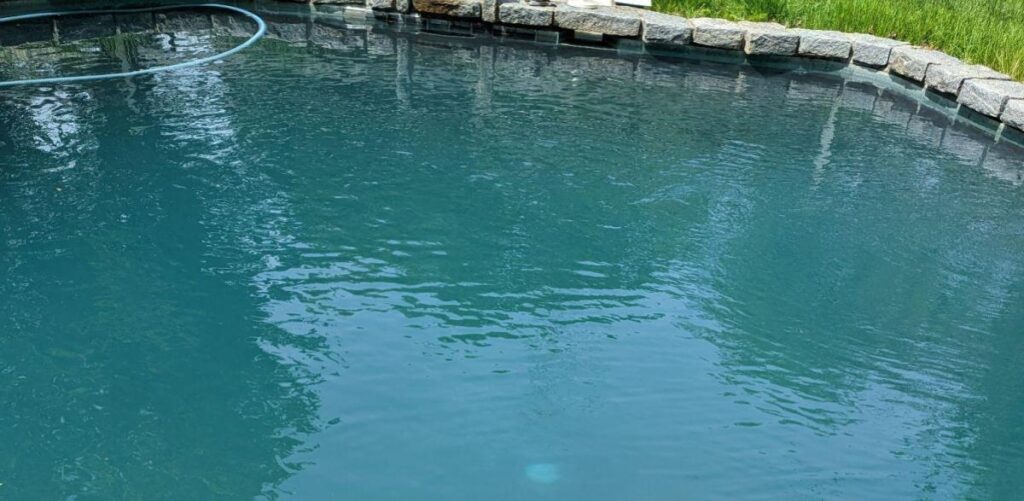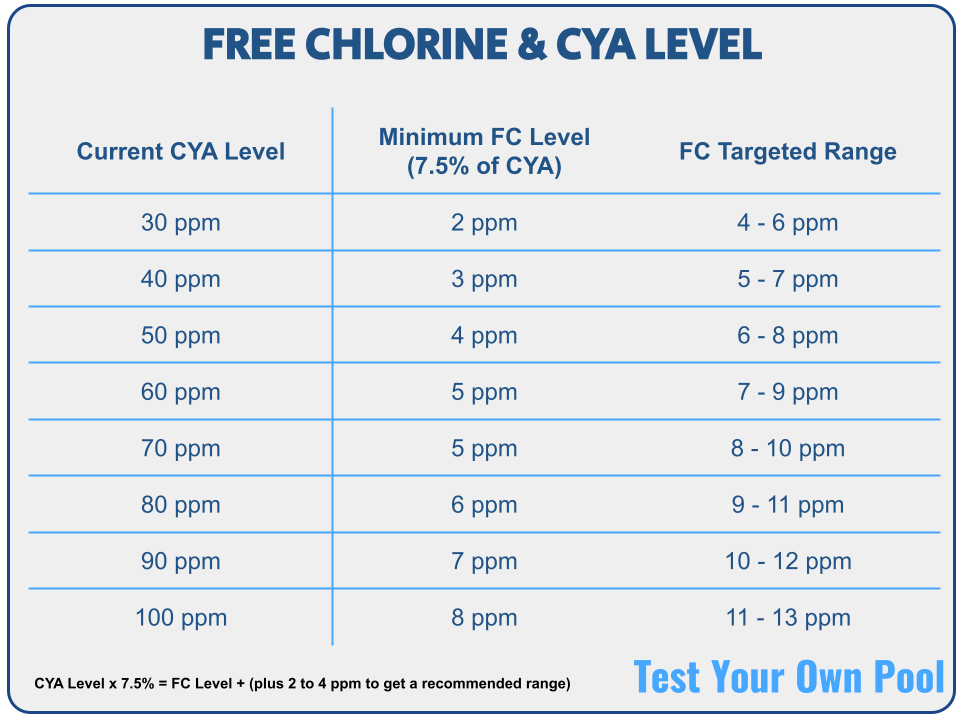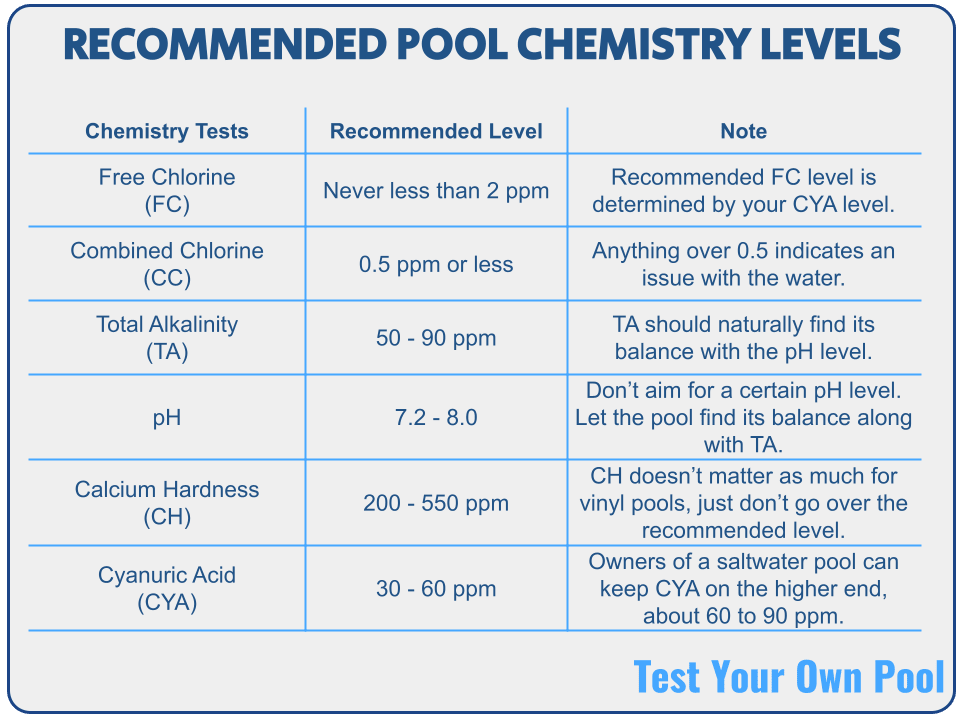All pool owners will experience their pool with cloudy water at one point or another. Sometimes, it can be cleared up fairly quickly. Other times, however, it may require some work and patience.
If you’re experiencing cloudy pool water, try to first diagnose what the cause is.

Low Levels of Chlorine
Let’s be clear and upfront about one item: almost all water issues start and end with pool chlorine.
Chlorine is eaten up by sunlight and organic contaminants. A pool that isn’t tested frequently can result in low chlorine levels. Low chlorine means these contaminants can start to spread, resulting in a water problem.
How to Fix: Test FC, CC, and CYA levels. Frequent free chlorine (FC) will tell you exactly how much chlorine is currently available in the water to fight off algae.
Use an accurate and reliable testing kit with FAS-DPD testing for the best results.
The most accurate and reliable pool testing kit.
Type of Chlorine Test: FAS-DPD
Read our full Taylor K-2006 Review.
Along with FC, testing combined chlorine (CC) will let you know how much chlorine is used to fight the “bad stuff.” In general, CC that measures 0.5 ppm and below indicates no water issue. Anything above 0.5 ppm will need to be dealt with.
Lastly, CYA levels must be known to understand how much chlorine is needed in the pool. Industry standards state that FC levels should be at least 7.5% of the pool’s CYA.

Improper Water Balance
Water balance ultimately is how pool water is clean and clear of organics. Chemistry parameters that are out of their recommended ranges can lead to several water issues, which all lead to some form of cloudiness.
High calcium hardness (CH) levels can plug pool filters, form white deposits or scale on surfaces, and cause cloudy water.
When pH levels are higher than recommended ranges, filters get plugged, causing circulation issues that can lead to cloudy water.
Total alkalinity (TA) that is not level will cause pH to bounce wildly, filters to get plugged, and also cause cloudy water!
How to Fix: Routine testing and chemical use. All chemistry parameters should be routinely tested to ensure water is always in the recommended ranges.
Set a testing schedule and stick to it. 5 minutes can save you days or weeks of hardships.
The use of recommended pool chemicals is all that is needed to balance the water. Everything else is just filler!

Poor Water Circulation
Poor water circulation and filtration will not properly move water through your system and remove harmful contaminants from the water.
How to Fix: Ensure proper water circulation at all times. Whether increasing the pool pump run time or checking the filter for damage, proper water flow reduces the chance of issues. Here are a few suggestions and routine pool maintenance checks:
- Clean the filter when the pressure reads 10 -12 PSI above the normal range. Depending on your filter type, either wash down and clean the grid cartridges or backwash.
- Check the filter for leaks or damage to the interior grids. As they get older, parts degrade and break down and might require a replacement
- Increase the pump’s run time so water can circulate longer.
- Check and clear the skimmer basket of leaves and other debris daily, including the pump basket.
Algae Outbreak
The least desirable outcome is the beginning of a green algae or mustard algae outbreak. Early algae spores will cause pool water to become hazy and cloudy.
If testing (and visually looking at the pool) confirms algae, you have a fight on your hands.
How to Fix: Prevent outbreaks with proper testing and water balance. The key to ensuring algae never becomes a large issue is to have clean water with proper amounts of chlorine.
Refer to the algae guides on how to completely eliminate algae problems. Spoiler: lots of chlorine and a whole heck of a lot of brushing!
Other Organic Contaminants
If your pool is cloudy but all chemistry levels are in range, it may be dirty water.
Pollen, sand, dirt, grass, leaves, and even Diatomaceous Earth (DE) from a DE filter will routinely enter the water and cause temporary cloudiness and water discoloration.
How to Fix: Brush and vacuum the pool. Debris isn’t inherently bad. In fact, it is very normal. Just make sure it doesn’t stay in the pool too long that it turns into something else.
Routine pool cleaning and testing will clear things like this right up!
Post-Storm Rain and Debris
Mother nature will come calling from time to time.
Rain is pretty harmless, with the exception that it might cause some chemistry balance problems that can easily be fixed.
As rain falls, it collects all the pollutants in the sky, like pollen, dust particles, and dirt, which can cloud the water. For the most part, this is temporary.
How to Fix: Cleaning, brushing, and balancing the water after the storm clears. First, check to make sure all equipment is OK and hasn’t been hit by any trees or large debris. If all looks good, follow these post-storm maintenance steps:
- Drain some water from the pool if necessary. Water should be midway between the skimmer’s throat.
- Brush, skim, and vacuum the pool as needed. Depending on the number of leaves and debris that fell into the pool, a filter clean and backwash may be necessary.
- Test the water and get it back to balanced levels with chemicals. If CC’s are showing any issues (remember above 0.5 ppm), there might be something growing that needs to be taken care of.
No Cloudiness in the Pool Forecast!
Seeing cloudy water initially can be frustrating, but for the most part, it can be fixed fairly quickly.
Stay diligent, keep testing and adding the right chemicals, and keep the water circulating!

